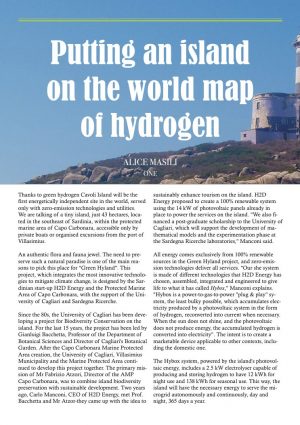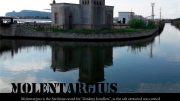 Thanks to green hydrogen Cavoli Island will be the first energetically independent site in the world, served only with zero-emission technologies and utilities.
Thanks to green hydrogen Cavoli Island will be the first energetically independent site in the world, served only with zero-emission technologies and utilities.
We are talking of a tiny island, just 43 hectares, located in the southeast of Sardinia, within the protected marine area of Capo Carbonara, accessible only by private boats or organised excursions from the port of Villasimius.
An authentic flora and fauna jewel. The need to preserve such a natural paradise is one of the main reasons to pick this place for “Green Hyland”. This project, which integrates the most innovative technologies to mitigate climate change, is designed by the Sardinian start-up H2D Energy and the Protected Marine Area of Capo Carbonara, with the support of the University of Cagliari and Sardegna Ricerche.
Since the 80s, the University of Cagliari has been developing a project for Biodiversity Conservation on the island. For the last 15 years, the project has been led by Gianluigi Bacchetta, Professor of the Department of Botanical Sciences and Director of Cagliari’s Botanical Garden. After the Capo Carbonara Marine Protected Area creation, the University of Cagliari, Villasimius Municipality and the Marine Protected Area continued to develop this project together. The primary mission of Fabrizio Atzori, Director of the AMP Capo Carbonara, was to combine island biodiversity preservation with sustainable development. Two years ago, Carlo Manconi, CEO of H2D Energy, met Prof. Bacchetta and Mr Atzori – they came up with the idea to sustainably enhance tourism on the island. H2D Energy proposed to create a 100% renewable system using the 14 kW of photovoltaic panels already in place to power the services on the island. “We also financed a post-graduate scholarship to the University of Cagliari, which will support the development of mathematical models and the experimentation phase at the Sardegna Ricerche laboratories,” Manconi said.
All energy comes exclusively from 100% renewable sources in the Green Hyland project, and zero-emission technologies deliver all services. “Our she system is made of different technologies that H2D Energy has chosen, assembled, integrated and engineered to give life to what it has called Hybox,” Manconi explains. “Hybox is a power-to-gas-to-power “plug & play” system, the least bulky possible, which accumulates electricity produced by a photovoltaic system in the form of hydrogen, reconverted into current when necessary. When the sun does not shine, and the photovoltaic does not produce energy, the accumulated hydrogen is converted into electricity”. The intent is to create a marketable device applicable to other contexts, including the domestic one.
The Hybox system, powered by the island’s photovoltaic energy, includes a 2.5 kW electrolyser capable of producing and storing hydrogen to have 12 kWh for night use and 138 kWh for seasonal use. This way, the island will have the necessary energy to serve the microgrid autonomously and continuously, day and night, 365 days a year.
This system avoids energy dispersion over time and overcomes the inefficiency of traditional batteries, allowing storage for prolonged times, even for years. In addition to protecting the environmental heritage, hydrogen production does not use any polluting component, either in the accumulation phase or energy release phase. Therefore it does not require any waste disposal process or by-products.
The needed water for hydrogen production will come in part from a moisture condensation system, known as Awg (Atmospheric water generator) called “hydropanel” and manufactured by Source Global, which is a partner of H2D in this project, and in part recovered from fuel cells during the conversion of hydrogen into electricity. The hydropanel system was designed to combine electricity consumption and occupied surface better. The choice of preferring an AWG system over a seawater desalinator is logically linked to environmental protection goals due to the generation of drinking water with hydropanels through the sun and the air in a fully sustainable design. The withdrawal of water from the sea would involve a modification of the marine ecosystem, in addition to generating the brine residue of desalination that requires disposal. The hydro panel reproduces exactly the natural rain process.
There is already a reverse osmosis system on the island to purify wastewater. “To ensure sustainable and environmentally friendly tourism, the project involves purchasing an electric motor boat, made of wood or recycled materials, in which, instead of the battery, there will be a hydrogen fuel cell”.
The protected marine area already has an electric vehicle, which will be modified with a hydrogen fuel cell, allowing disabled people to visit the island. Two hydrogen-charging stations will be built. One will be placed on the island and powered by the system described. The other will be built in the Villasimius quay – a similar design powered by a 20 kW photovoltaic system.
This project could open the door to more opportunities to support sustainable navigation and create areas reserved for ecological boats. The work has already begun. After assessing the physical sizing of the components and the purchase of materials for their construction, the performance assessment of all the features and the feasibility of the integrated system will start at Sardegna Ricerche’s Renewable Energy platform. Then the system will be moved to the island. It should be operative in less than a year.
For the first time in a manufactured system, energy, sanitary water, wastewater, and land or marine mobility are combined and provided through technologies with zero emissions and no environmental damage—a real jump into a sustainable future for humanity.
Alice Masili


